Name USS Mustin Ordered 6 March 1998 Commissioned 26 July 2003 Construction started 15 January 2001 Length 155 m Displacement 8.346 million kg | Laid down 15 January 2001 Homeport Yokosuka, Japan Launched 12 December 2001 Weight 9,348 tons | |
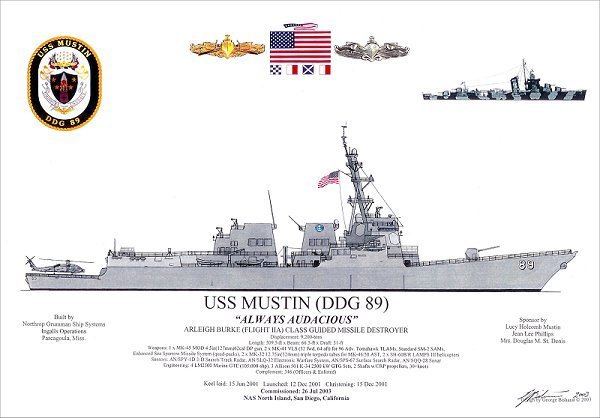 | ||
U s navy guided missile destroyer uss mustin ddg 89 at tokyo bay
USS Mustin (DDG-89) is an Arleigh Burke-class guided missile destroyer in the United States Navy. She is named in honor of the Mustin family who has devoted nearly a century of U.S. Naval service. This ship is the 39th destroyer of its class. USS Mustin was the 18th ship of this class to be built at Ingalls Shipbuilding in Pascagoula, Mississippi, and construction began on 15 January 2001. She was launched on 12 December 2001 and was christened on 15 December 2001. On 26 July 2003, a twilight ceremony was held at the Naval Air Station North Island in San Diego, California. For many years she was part of Destroyer Squadron 15, based at Yokosuka, Japan.
Contents
- U s navy guided missile destroyer uss mustin ddg 89 at tokyo bay
- Ship history
- Awards
- Commanding officers
- Shield
- Crest
- Motto
- Seal
- References
Ship history
On 1 February 2005 USS Mustin began her maiden deployment and returned on 1 August.
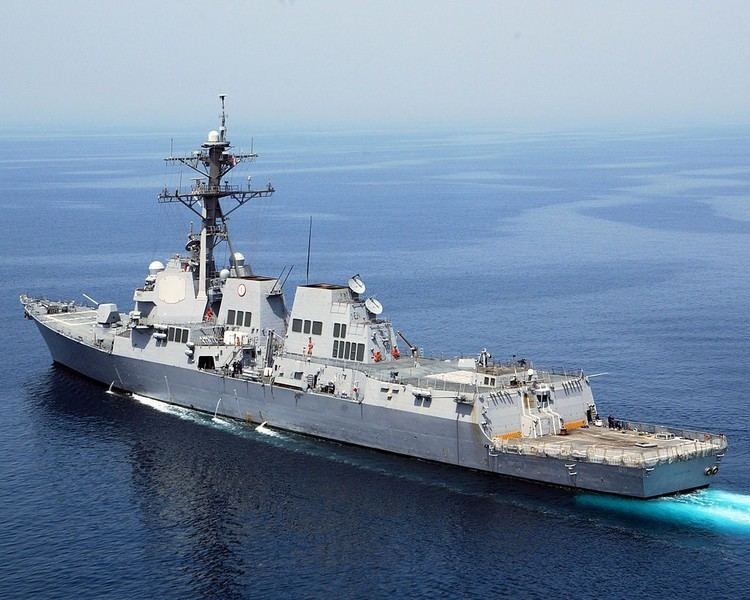
In July 2006, Mustin and her crew of 300 were deployed to Yokosuka Naval Base in Yokosuka, Japan, home of the Navy's 7th Fleet, for permanent assignment. Though coming at a time in response to the recent North Korea missile tests, the deployment was previously ordered, unrelated to the incidents.
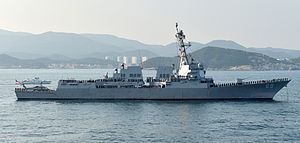
During the 2008 Myanmar Cyclone Nargis crisis and the subsequent Operation Caring Response aid mission, as part of the USS Essex Amphibious Ready Group (also including the USS Juneau and the USS Harpers Ferry), she stood by off Burma from 13 May to 5 June, waiting for the Myanmar junta government to permit US aid to its citizens. However, in early June, with permission still not forthcoming, it was decided to put the group back on its scheduled operations.
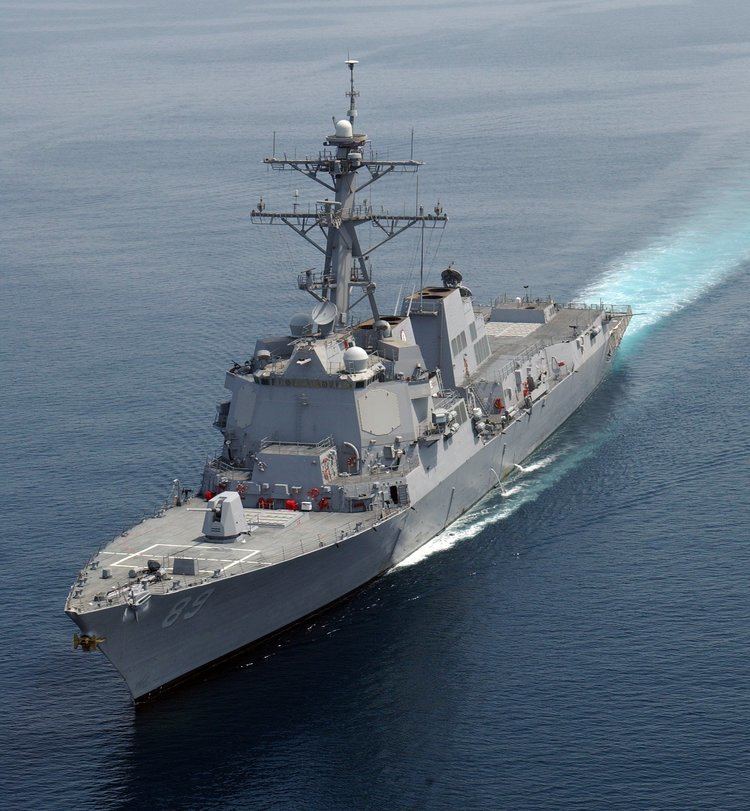
In March 2011, in company with the aircraft carrier Ronald Reagan, the ship was deployed off northeastern Honshu, Japan. The mission was to assist with relief efforts after the 2011 Tōhoku earthquake and tsunami.
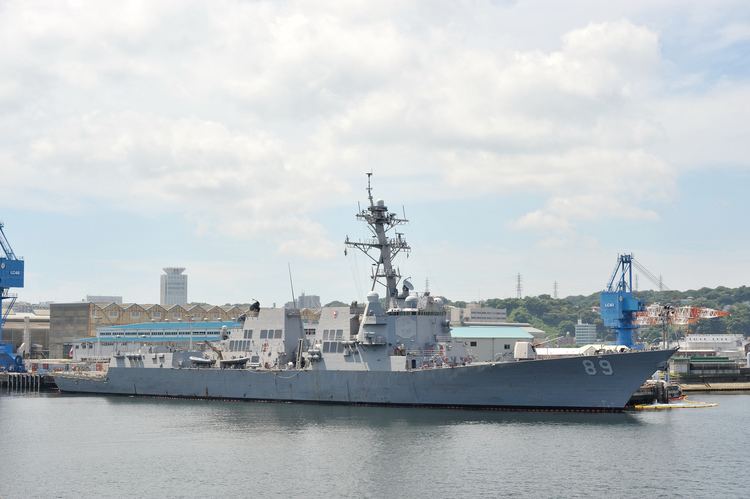
During the 2011 Thailand floods, the ship was docked at Port Laem Chabang on a routine visit when the Thai government asked for assistance in aerial surveillance of the extent of Bangkok flooding. Captain John Kirby said Thailand had asked the warship to prolong its stay at the port for up to six days; the Pentagon said the two Seahawk helicopters, from HSL-51 detachment SIX, aboard would conduct the reconnaissance.
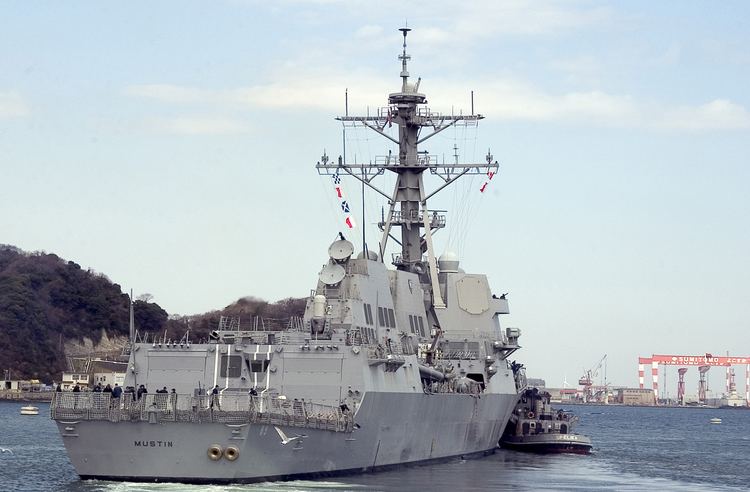
In November 2013, Mustin was sent to the Philippines as part of the U.S. aid mission after the country (especially the city of Tacloban and Leyte Province) was devastated by Super Typhoon Haiyan.
Awards
Mustin has been awarded the Navy E Ribbon for 2004, 2005, 2008 and 2010 Mustin also received the Humanitarian Service Medal for 11 March 2011 to 31 May 2011. During the time of the 2011 Tōhoku earthquake and tsunami. As part of Task Force 70, Mustin received the Meritorious Unit Commendation for 10 April 2012 to 31 December 2013.
Commanding officers
The Commanding Officer (CO) of USS Mustin (DDG-89) is the most senior officer that is in command of the ship. Sailors will refer to the CO as "the Captain" (regardless of rank), or sometimes informally as "Skipper". Below is the list of commanding officers of USS Mustin.
Shield
The shield has background of blue with four gold stars, an inflamed delta, a triple barreled battleship gun, annulet and polestar.
The traditional Navy colors were chosen for the shield because dark blue and gold represents the sea and excellence respectively. The inflamed delta symbolizes VADM Henry C. Mustin’s initiation of the Tomahawk weapons system which diversified surface combatants missile capabilities. The flames five points denote the wars that Mustin family members fought. VADM Lloyd M. Mustin’s career gunnery expertise is represented by the battleship gun turret. The three barrels of the turret represent the three generations of Mustin family members who endured combat under fire. The red annulet signifies unity, courage and valor. The polestar honors VADM Henry C. Mustin, Deputy Chief of Naval Operations who also commanded NATO’s largest fleet. The annulet and polestar combined symbolize VADM Henry C. Mustin’s development of the early gun sight that lead to a computing anti-aircraft gunsight developed by VADM Lloyd M. Mustin. The gun sights were key to U.S. Navy’s success with anti-aircraft action from the Pacific in World War II. The four stars honor the Bronze Stars earned by the Mustin Family for their Vietnam service.
Crest
The crest consists thirteen stars over a Surface Warfare Officer device bounded by palm fronds and dolphins.
The thirteen stars memorialize the thirteen battle stars from the Asiatic Pacific Area Service Ribbon which the first USS Mustin earned for contribution to World War II Pacific operations. The dolphins symbolize search and rescue, referring to the first USS Mustin rescue of 337 crewmen of USS Hornet, which was hit by a torpedo. The palm fronds signify victory and achievement in the Pacific. The Surface Warfare Officer device reflects the Mustin Family’s sea service and the two destroyer’s excellence of surface warfare.
Motto
The motto is written on a scroll of white with blue trim.
The ships motto is "Toujours L’Audace" or "Always be Bold".
Seal
The coat of arms in full color as in the blazon, upon a white background enclosed within a dark blue oval border edged on the outside with a gold rope and bearing the inscription "USS Mustin" at the top and "DDG 89" in the base all gold.
